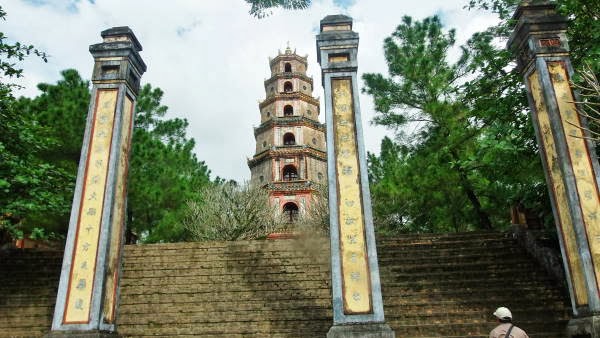Da Nang, en route from Hoi An to Hué
Am Weg von Hoi An nach Hué fuhren wir durch Da Nang (Drachenbrücke)
Hải Vân Pass ("Ocean Cloud Pass"), a weather divide between north and south
Below: view looking south
Below: view looking south
Hải Vân Pass (Wolkenpass)- Blick....Richtung Da Nang...
and to the north
..... Hué
At the top of the pass (avoiding the ubiquitous souvenir stands)
Passhöhe
We were upgraded to what was actually a "honeymoon Suite"
Im Hotel wurden wir auf die "Honeymoon Suite" upgegradet.
which included a sunken bath tub (easily big enough for three adults)
and an open-air shower.
We even had our own private swimming pool
the dimensions of which did not however match the spacious suite.
Birthday dinner - first cake and meal with compliments of the travel agency
1. Geburtstagstorte
and second cake with compliments of the hotel.
Nach dem mehrgängige Dinner- 2.Torte..
Next morning, outing to the Thien Mu Pagoda (dedicated to the sky goddess)
Nächster Tag: Parfümfluss
by boat along the Perfume River. We were the only passengers...
Mit dem Boot zur Thien Mu Pagode
Thien Mu Pagode- Eingang
The pavilion behind the pagoda houses the largest bell in Hué (1710). When struck, its sound could be heard 10 km away.
Neben der Pagode ist die größte Glocke Hués (gegossen 1710, 3285kg schwer, 2,5m hoch)- sie 10km weit hörbar.
Entrance archway to the courtyard which houses a monastery
Ngu Mon (das "Dreiflügelige Tor") führt, an Wächter vorbei, in den Hof.
Thich Quang Duc, a monk from here, was visiting a monastery in Saigon. On 11 June 1963, he got out of the car exhibited below, sat in the lotus position in a Saigon street, and burnt himself to death in protest against the Diem régime's policies of discrimination against Buddhists and violating religious freedom.
Neben diesem Auto verbrannte sich am 11.6.1963 der Mönch Thich Quang Duc in Saigon. Er wollte damit gegen die Unterdrückung durch die südvietnamesische Regierung und die USA protestieren.
Klostergarten
Ride through....
Fahrt zum...
Hué market
Markt
Visited the tomb of the Nguyen Emperor Tu Duc (1848-83), the construction of which was completed in 1867. Tu Duc also used the tomb complex as a retreat during his lifetime. The Emperor himself was a poet and created a miniature world for contemplation and to recite and compose poetry with a lake, wood, hills, plants and islands to escape from the strict ceremonial world of the Imperial City.
Grab von König Tu Duc (1847-1883) wurde 1867 fertiggestellt. Der König benutzte die Anlage bis zu seinem Tod als Sommersitz.
The imperial landing stage on the lake in the grounds of the complex
Bootssteg bei künstlich angelegten Teich.
Passing through the courtyard on the way to the sarcophargus
Auf dem Weg zum Grab: Statuen v. Tieren, wichtigen Beamten und Generäle.
Inside the Emperor's living quarters -below the throne room.
Räume des Königs: hier durfte nur der König und Seine Frau sich aufhalten.
Remains of the concubines' living quarters (only about 20 of over 100 lived here)
Daneben die Überreste des Wohntraktes der Konkubinen (hier wohnten von den über hundert nur ca. 20.
The Emperor's tomb
Königsgrab....
Tu Duc's corpse was actually buried not here, but at a secret location somewhere in Hué.
...wobei es nicht sicher ist ob sich der Leichnam wirklich hier befindet.
Blick vom Sarkophag auf Anlage
This concrete mausoleum was built during 1920-31and reflects a combination of Vietnamese, Chinese and European styles of architecture.
Dieses aus Beton zwischen 1920-31 errichtete Mausoleum ist eine Kombination aus europäischen, vietnamesischen und chinesischen Baustilen.
With over 100 steps it's a steep climb up to the mausoleum
Courtyard with stone figures of elephants, horses and mandarins
Auch hier, wie bei den chinesischen Ming Gräbern, Darstellungen von Tieren und verdienten Persönlichkeiten.
Peek-a-boo!
Portrait of the Emperor
In dieser Halle ist der König begraben.- Wände sind Glas und Keramikfliesen bedeckt.(nicht unbedingt mein Geschmack)
The interior is a kind of pseudo-European/French rococo monstrosity tiled with fragments of ceramics and glass for decoration.
It is however proven that the Emperor Khai Dinh is buried here.








































Keine Kommentare:
Kommentar veröffentlichen